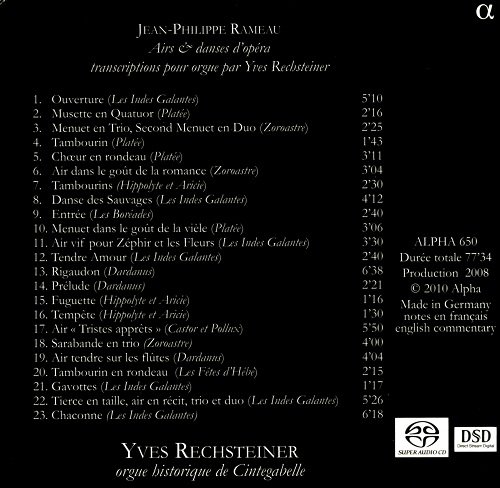
Yves Rechsteiner - Rameau: Air et danses d'opera (2010) [SACD]
BAND/ARTIST: Yves Rechsteiner
- Title: Rameau: Air et danses d'opera
- Year Of Release: 2010
- Label: Alpha [ALPHA650]
- Genre: Classical
- Quality: DSD64 image (*.iso) / 2.0 > 1-bit/2.8224 MHz
- Total Time: 01:17:40
- Total Size: 3,7 GB (+3%rec.)
- WebSite: Album Preview
The organ is not just a musical instrument; it’s also a fascinating machine, whose complexity has increased over the centuries. This new collection aims to discover and to get closely acquainted with them within the context that surrounds the instrument. It’s quite normal, when entering into a church, to look up and see if an instrument is installed in the building. An organ is not merely about producing sounds, it occupies a place in space and architecture. In order to reflect the power of this spatiality, Alpha have decided to use multi-channel sound in 5.1, for the benefit of music lovers equipped with SACD technology. By introducing instruments chosen for their exceptional features, they wish to make the personality of each instrument more distinguishable. The first reference of the collection is devoted to the organ of Cintegabelle, near Toulouse, consecrated in 1747, uprooted during the French Revolution and refurbished in 1989, a magnificent instrument whose sounds colour an original programme of transcriptions compiled from Rameau’s operas, interpreted by Yves Rechsteiner.
The new collection has, of course, the ‘Alpha touch’: fine presentation, digi-book format, scholarly texts, copiously illustrated with quality pictures.
Why the name of Ugab? Because the organ’s original ancestor appears (presumably) under that name in the Old Testament, back in the mists of time…The first wind instrument mentioned in the Bible is the ugab, or reed-pipe as some call it. The word 'ugab’ may also be found in English Bibles as "flute" or "organ." The reed-pipe, or simply pipe, probably is the most accurate term for the ugab. This name suggests a proper description of the instrument that was a long, narrow hollow stem, or reed, with holes to change the pitch to achieve a melody. Although the ugab was played as a spiritual instrument (Ps. 150:4), it was also known for awakening physical and emotional passions that were not desirable before the Lord.
Tracks:
![Yves Rechsteiner - Rameau: Air et danses d'opera (2010) [SACD]](https://www.dibpic.com/uploads/posts/2020-02/1580996398_tr.jpg)
Personnel:
Yves Rechsteiner (Cintegabelle organ),
Henri-Charles Caget (percussion)

The new collection has, of course, the ‘Alpha touch’: fine presentation, digi-book format, scholarly texts, copiously illustrated with quality pictures.
Why the name of Ugab? Because the organ’s original ancestor appears (presumably) under that name in the Old Testament, back in the mists of time…The first wind instrument mentioned in the Bible is the ugab, or reed-pipe as some call it. The word 'ugab’ may also be found in English Bibles as "flute" or "organ." The reed-pipe, or simply pipe, probably is the most accurate term for the ugab. This name suggests a proper description of the instrument that was a long, narrow hollow stem, or reed, with holes to change the pitch to achieve a melody. Although the ugab was played as a spiritual instrument (Ps. 150:4), it was also known for awakening physical and emotional passions that were not desirable before the Lord.
Tracks:
![Yves Rechsteiner - Rameau: Air et danses d'opera (2010) [SACD]](https://www.dibpic.com/uploads/posts/2020-02/1580996398_tr.jpg)
Personnel:
Yves Rechsteiner (Cintegabelle organ),
Henri-Charles Caget (percussion)

As a ISRA.CLOUD's PREMIUM member you will have the following benefits:
- Unlimited high speed downloads
- Download directly without waiting time
- Unlimited parallel downloads
- Support for download accelerators
- No advertising
- Resume broken downloads


![Yves Rechsteiner - Rameau: Air et danses d'opera (2010) [SACD]](https://www.dibpic.com/uploads/posts/2020-02/1580996451_folder.jpg)